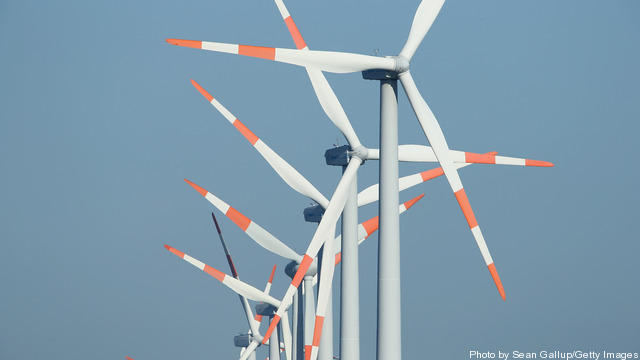
The wind industry has a deal for lawmakers: they’re willing to sacrifice their tax credit for deficit reduction, as long as it’s not snatched away too quickly. Wind turbine makers say they’re OK with an industry plan to gradually phase out its tax credit as part of the fiscal cliff discussion — provided lawmakers extend it for another six years. The wind industry has been fretting that its tax credit – which covers about 30% of the cost of wind power — won’t be renewed when it expires at the end of 2012. The industry says up to 37,000 jobs are on the line if the credit expires. In a bid to prevent that from happening, the American Wind Energy Association said last week that the industry can compete against other power sources like coal and natural gas by 2018, so long as the credit doesn’t disappear before then.
Politics
Sign up and get Breaking Energy news in your inbox.
We will never sell or share your information without your consent. See our privacy policy.
Five years isn’t long in the energy business, where project development cycles can stretch into decades. That makes the emergence of the cellulosic biofuels business as a commercial force in the US in the past five years even more striking.
While the industry is making rapid strides to commercial maturity and widespread use, it has lacked common templates for creating and building successful production facilities that can be integrated into all-important infrastructure. The Advanced Ethanol Council, only five years after Congress called for aggressive development to alleviate US dependence on foreign oil and the Renewable Fuel Standard was signed, is seeking to provide highly detailed information about those facilities that are under development. Keep reading →

While the nation has been focused on new sources of natural gas and shale oil, few noticed the slow decline of an older energy source, nuclear power. Today, commercial nuclear power is struggling to stay in the game.
The power markets are hammering the nation’s nukes. Over a decade ago, several regions decided to create Regional Transmission Organizations (or Independent System Operators) and use the market to set power prices. Today, North America has ten independent RTOs/ISOs, where wholesale power is auctioned every few minutes. Keep reading →

For much of the past decade the answer to almost any major economic question had at least a little bit of “China” in its answer, and for energy the growth of what has become the world’s second largest economy and remains its most populous nation has been central to market growth and disruption.
Without China’s growth, oil prices would have been lower, leavening the expensive and much-debated fight over the race to renewable power in the US. With less growth in China, natural gas companies in the US might have had fewer buyers for their barely profitable (or even loss-making) fields as the technology developed to expand production in turn brought down prices. Keep reading →

A new plan for deep cuts in carbon emissions from US power plants is designed to help counteract climate change and reduce health risks but could also lead to more job cuts in the beleaguered coal industry.
The environmental group Natural Resources Defense Council recently issued the proposal that would use existing technologies to cut generators’ carbon pollution by 26 percent by 2020 and 34 percent by 2025, also reducing emissions of other pollutants such as sulfur dioxide and nitrogen oxides. Keep reading →

It hardly seems possible but after President Obama authorized up to $2 billion last year to support energy efficiency upgrades in federal buildings, only a handful of agencies took him up on the offer. But a new bipartisan House effort, the Energy Savings Performance Caucus, plans to get the ball rolling.
Reps. Cory Gardner (R-CO) and Peter Welch (D-VT) said the intent of the new caucus is to “push for policies that reduce energy costs, cut pollution and create jobs,” according to a Sustainable Business story. Keep reading →

If US solar manufacturers were looking to recently upheld trade tariffs to provide relief from the onslaught of low-priced Chinese panels that has decimated the US industry, they may be disappointed, industry participants said.
Duties of 24 to 36 percent on most solar panels imported from China, as confirmed by the US International Trade Commission in early November, are not expected to drive up prices or make US manufacturers more competitive because of a loophole in the regulation that allows low-cost Chinese producers to avoid the tariffs if they make the solar assemblies outside China. Keep reading →

Commercial oil sands development dates back to the 1960’s, but the process continued largely unnoticed by the international community until the early 2000’s when the resources’ proven reserves were widely publicized. Although the government of Alberta had been working to communicate the importance of the oil sands as an energy source and economic driver, the province’s leadership was taken by surprise when the environmental community trained its crosshairs on the large-scale industrial mining operations.
The debate between the environmental community, regulators, industry and stakeholders about the environmental costs versus the economic benefits of oil sands development has evolved over the years and continues today. Keep reading →

Can government stimulate investment in renewable energy generation by guaranteeing an electricity price for developers of sources such as wind and nuclear?
The UK government thinks it can, and recently introduced a long-awaited bill that would set a “strike price” for power generated by low-carbon producers, and recover the costs from consumers via electricity suppliers. Keep reading →
